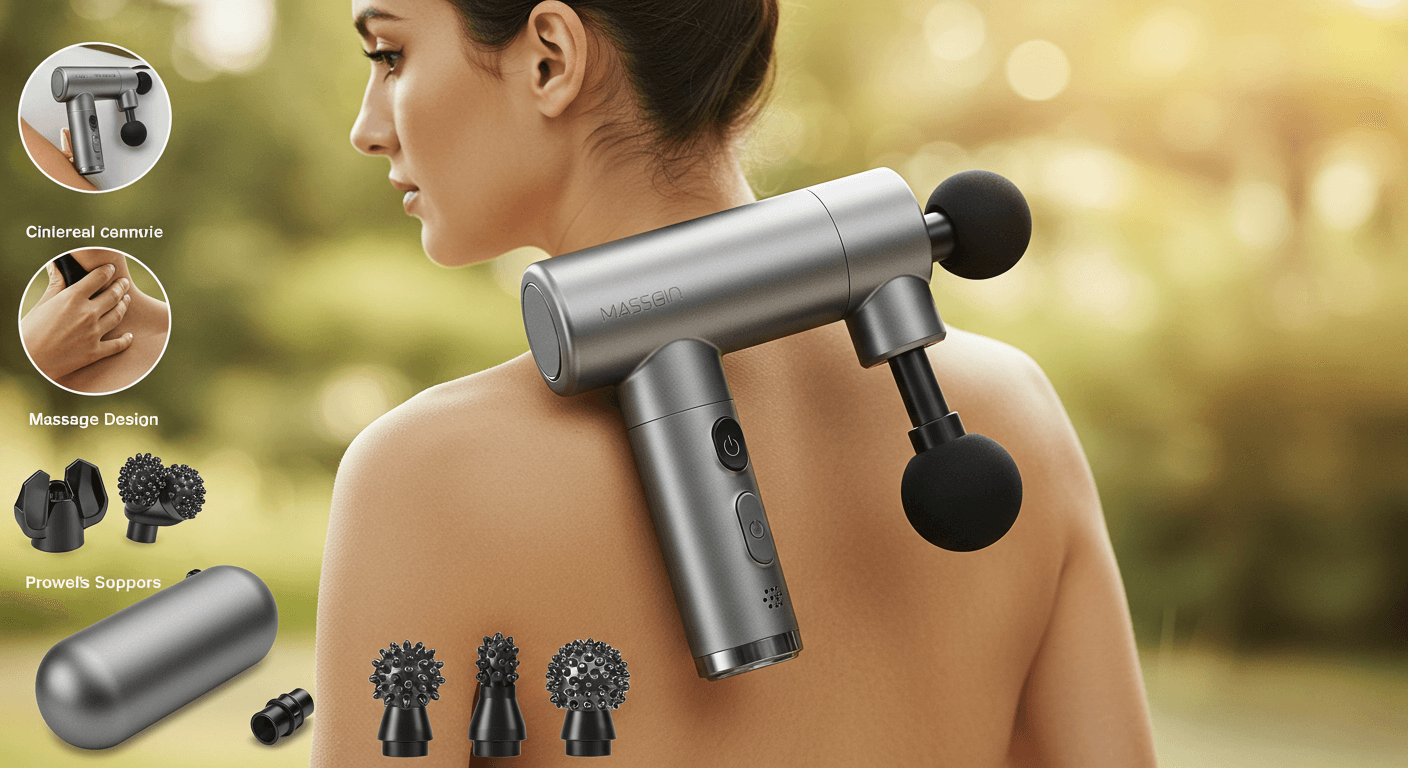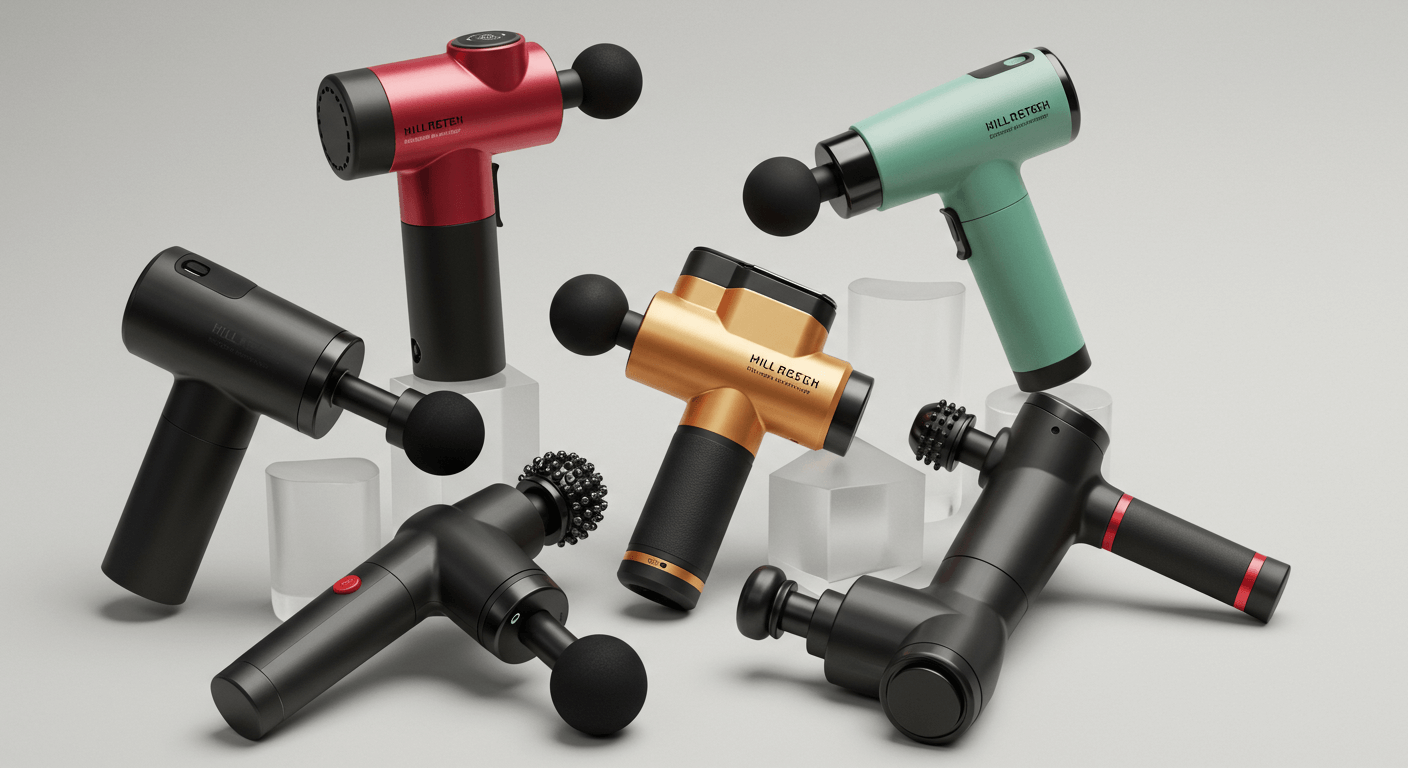Fitness lovers and athletes are constantly searching for methods to enhance performance, lessen discomfort, and recover more quickly. One of the most widely used recovery aids in the sports and fitness industry in recent years is the massage gun, sometimes referred to as a percussion or percussive therapy gadget. These portable gadgets are frequently seen in gyms, training centres, and even professional locker rooms because they offer advantages like decreased muscle tension, enhanced circulation, and quicker recovery times.
However, are there any real effects of massagers on sports performance? Strength, endurance, and injury prevention all depend on recovery. Muscles that don’t recover properly stay painful, stiff, and more prone to strain. In order to replicate some of the advantages of traditional massage, massage guns are made to apply quick bursts of pressure deep into muscle tissue. After vigorous exercise, this can help release tense muscles, increase blood flow, and possibly lessen delayed onset muscle soreness (DOMS).
Research on the effects of massage guns on both short-term recovery and long-term athletic performance is expanding, along with interest. Athletes are using massage guns to maximize their routines for everything from pre-workout muscle activation to post-training recovery. Although they are not a panacea, many discover that strategically employing them improves their mental preparedness for competition, flexibility, and mobility.
This post will explain what massagers are, how they affect muscles, and what research has to say about how they affect performance and recuperation. We’ll also go over the benefits and drawbacks for athletes, how to use them safely, and how massagers work with a full training and recuperation regimen. By the end, you’ll know exactly how to use massage guns and whether they can actually improve athletic performance.
What Are Massage Guns?
Massage guns, sometimes referred to as percussion massagers or percussive therapy devices, are portable instruments made to apply quick pressure bursts to specific muscles. They have grown in popularity among athletes, fitness fanatics, and even regular people looking to relieve stiffness and soreness in their muscles. Massage guns use rapid, repetitive pulses to stimulate deeper layers of muscle tissue, in contrast to traditional massage, which depends on steady hand pressure.
Users can adjust the intensity and target particular muscle groups with these devices’ various speed settings and interchangeable attachments. For instance, bullet-shaped attachments are better at locating small or difficult-to-reach areas, while round heads are frequently used for large muscles like the quadriceps or glutes.
Percussive therapy, the idea behind massage guns, is a method designed to increase blood flow, ease tense muscles, and hasten the healing process following physical activity. By delivering rapid, concentrated vibrations, massage guns can help break up knots, stimulate blood flow, and ease discomfort associated with delayed onset muscle soreness (DOMS).
Massage guns differ from foam rollers or stretching in that they provide a more localized and intense form of muscle stimulation. Their portability and convenience make them especially attractive for athletes who want quick relief before or after workouts. Some even use them during warm-ups to activate muscles and improve flexibility.
While massage guns do not replace professional massage therapy or medical treatment, they offer a practical way to support recovery and maintain performance. For athletes and active individuals, they serve as a valuable addition to training and recovery routines, bridging the gap between professional care and at-home self-maintenance.
How Massage Guns Affect Muscles
Massage guns work by delivering rapid bursts of pressure, also called percussive therapy, directly into muscle tissue. This action has several effects on the body that support recovery and enhance comfort after physical activity. One of the primary benefits is increased blood flow. The repetitive pulses stimulate circulation, bringing oxygen and nutrients to muscles while helping remove metabolic waste like lactic acid. Better blood flow supports faster recovery and reduces fatigue after workouts.
Another important effect is muscle relaxation and tension release. Tight or overworked muscles often hold onto tension that can limit movement and flexibility. The deep pressure of a massage gun helps loosen these tight spots, making it easier to move freely and reducing the risk of strains or injuries.
Massage guns also stimulate nerve receptors in the skin and muscles, which can temporarily block pain signals sent to the brain. This creates a soothing effect, making them especially useful for reducing discomfort from delayed onset muscle soreness (DOMS) that appears 24 to 48 hours after exercise.
Additionally, regular use can improve muscle flexibility and range of motion. Athletes often find that using a massage gun before workouts helps “wake up” their muscles, priming them for performance. Post-workout use, on the other hand, focuses on relaxation and recovery.
While massage guns provide many benefits, proper use is important to avoid overuse or irritation, especially on sensitive areas. When used correctly, they serve as an effective tool to complement stretching, foam rolling, and other recovery strategies.
Overall, massage guns positively affect muscles by boosting circulation, reducing soreness, and enhancing flexibility, helping athletes and active individuals recover faster and perform better.
The Science: Massage Guns and Recovery

Scientific interest in massage guns has grown alongside their popularity in sports and fitness. Research on percussive therapy, the technique behind massage guns, suggests that these devices can play a role in supporting muscle recovery, improving mobility, and reducing soreness after exercise.
One of the most studied effects is the reduction of delayed onset muscle soreness (DOMS), which typically develops 24 to 72 hours after intense activity. Studies indicate that massage techniques, including percussive therapy, can decrease muscle stiffness and discomfort by improving blood circulation and stimulating muscle tissue. This helps the body clear waste products like lactic acid more efficiently, reducing the heavy, sore feeling athletes often experience after workouts.
Another scientific benefit lies in enhanced range of motion and flexibility. Research shows that targeted vibration or percussion can temporarily increase muscle elasticity and joint mobility. This means that athletes using massage guns as part of their warm-up may experience improved performance due to greater freedom of movement.
Massage guns have also been compared with foam rolling and other recovery tools. While both methods increase circulation and decrease muscle tightness, massage guns deliver a more localized and concentrated stimulus. For many athletes, this means quicker and more effective relief, especially in hard-to-reach muscle groups.
Although studies are still ongoing, early evidence supports the idea that massage guns help reduce soreness, improve circulation, and prepare muscles for performance. However, experts note that they should be used as part of a broader recovery plan that includes rest, proper nutrition, stretching, and hydration.
In short, the science suggests that massage guns are not a miracle solution, but they are a valuable addition to recovery routines, helping athletes train consistently while reducing downtime.
Massage Guns and Athletic Performance
Massage guns are not only about recovery; they can also play a role in boosting athletic performance when used strategically. Athletes use these devices both before and after workouts to maximize training results, reduce downtime, and prepare the body for peak performance.
When used before exercise, massage guns help with muscle activation. The rapid bursts of pressure stimulate blood flow and warm up muscle tissue, which can improve flexibility and mobility. This priming effect allows muscles to respond more effectively during physical activity, reducing stiffness and lowering the risk of injury. Many athletes report feeling more agile and prepared for explosive movements such as sprinting, jumping, or lifting.
Post-workout, massage guns are valued for their ability to accelerate recovery. By easing tension and reducing delayed onset muscle soreness (DOMS), they allow athletes to return to training more quickly. This consistency is vital for performance gains, as long gaps caused by soreness or fatigue can disrupt progress.
Massage guns may also support endurance and strength indirectly. When muscles recover faster and perform with less stiffness, athletes can train harder and more frequently. This cycle contributes to improved strength, power, and stamina over time.
Another often-overlooked benefit is the psychological edge. The soothing effect of massage guns can reduce stress, calm the nervous system, and promote mental readiness before competition. Feeling physically and mentally prepared gives athletes more confidence in their performance.
While massage guns cannot replace structured training, rest, or proper recovery practices, they can be a powerful complement. Used wisely, they help athletes warm up effectively, recover faster, and train at a higher level; three essential factors for long-term athletic success.
Tips for Using Massage Guns Safely
Massage guns are powerful tools for recovery and performance, but using them safely is essential to avoid injury or discomfort. Following best practices ensures athletes can maximize benefits while minimizing risks.
- Start Slowly: Begin with the lowest speed or intensity setting. This allows muscles to adjust to percussive therapy without causing irritation or soreness. Gradually increase intensity as comfort and tolerance improve.
- Focus on Major Muscle Groups: Target large muscle groups like the quadriceps, hamstrings, glutes, and back for effective relief. Avoid using massage guns directly on joints, bones, or sensitive areas to prevent bruising or damage.
- Limit Session Duration: Use the massage gun on a single muscle group for no more than 1–2 minutes at a time. Overuse can lead to tissue irritation or soreness instead of recovery.
- Keep the Gun Moving: Avoid staying in one spot for too long. Slowly move the device along the muscle to evenly distribute pressure and prevent localized discomfort.
- Combine with Other Recovery Practices: Massage guns are most effective when paired with stretching, hydration, and proper nutrition. These complementary strategies enhance recovery and overall performance.
- Listen to Your Body: Discomfort is normal, but sharp pain or excessive bruising is a sign to stop immediately. Adjust pressure, speed, or duration as needed.
- Consult a Professional if Needed: Athletes with injuries or chronic conditions should seek guidance from a healthcare provider before using a massage gun.
By following these guidelines, athletes can safely incorporate massage guns into their routines for improved flexibility, faster recovery, and enhanced performance. Proper usage ensures that the device remains a valuable, effective, and safe tool in any training regimen.
Conclusion

Massage guns have emerged as a popular tool for athletes and fitness enthusiasts seeking faster recovery and improved performance. By delivering targeted percussive therapy, these devices help increase blood flow, reduce muscle stiffness, and alleviate soreness after workouts. Pre-workout use can activate muscles and enhance flexibility, while post-workout sessions support quicker recovery, allowing athletes to maintain consistent training schedules.
Scientific evidence supports the benefits of percussive therapy, particularly for reducing delayed onset muscle soreness (DOMS) and improving range of motion. While not a replacement for professional care or comprehensive recovery strategies, massage guns provide a convenient, portable, and effective complement to stretching, hydration, and proper nutrition.
Understanding the proper use of massage guns is essential to maximize their effectiveness and preventing potential overuse or injury. Starting with lower intensity, targeting major muscle groups, and keeping sessions brief ensures safe and beneficial outcomes.
For athletes aiming to enhance performance, maintain mobility, and speed recovery, massage guns offer a practical, evidence-backed tool. When integrated wisely into training routines, they can help achieve consistent results, reduce downtime, and support long-term physical fitness goals.
